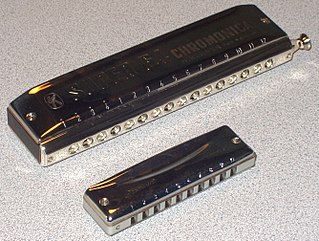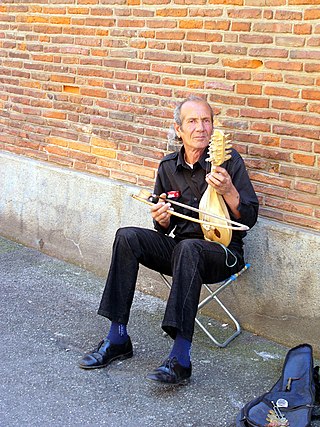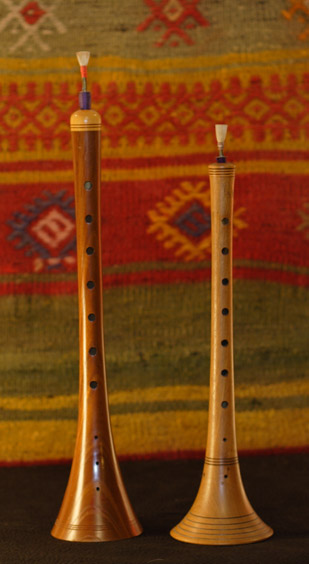
Bagpipes are a woodwind instrument using enclosed reeds fed from a constant reservoir of air in the form of a bag. The Great Highland bagpipes are well known, but people have played bagpipes for centuries throughout large parts of Europe, Northern Africa, Western Asia, around the Persian Gulf and northern parts of South Asia.
The clarinet is a single-reed musical instrument in the woodwind family, with a nearly cylindrical bore and a flared bell.

The harmonica, also known as a French harp or mouth organ, is a free reed wind instrument used worldwide in many musical genres, notably in blues, American folk music, classical music, jazz, country, and rock. The many types of harmonica include diatonic, chromatic, tremolo, octave, orchestral, and bass versions. A harmonica is played by using the mouth to direct air into or out of one holes along a mouthpiece. Behind each hole is a chamber containing at least one reed. The most common is the diatonic Richter-tuned with ten air passages and twenty reeds, often called the blues harp. A harmonica reed is a flat, elongated spring typically made of brass, stainless steel, or bronze, which is secured at one end over a slot that serves as an airway. When the free end is made to vibrate by the player's air, it alternately blocks and unblocks the airway to produce sound.
The roots of traditional music in Turkey span across centuries to a time when the Seljuk Turks migrated to Anatolia and Persia in the 11th century and contains elements of both Turkic and pre-Turkic influences. Much of its modern popular music can trace its roots to the emergence in the early 1930s drive for Westernization.

The chalumeau is a single-reed woodwind instrument of the late baroque and early classical eras. The chalumeau is a folk instrument that is the predecessor to the modern-day clarinet. It has a cylindrical bore with eight tone holes and a broad mouthpiece with a single heteroglot reed made of cane. Similar to the clarinet, the chalumeau overblows a twelfth.

The gadulka is a traditional Bulgarian bowed string instrument. Alternate spellings are "gǎdulka", "gudulka" and "g'dulka". Its name comes from a root meaning "to make noise, hum or buzz". The gadulka is an integral part of Bulgarian traditional instrumental ensembles, commonly played in the context of dance music.
Northwest Iberian folk music is a traditional highly distinctive folk style, located along Spain's north-west Atlantic coast, mostly Galicia and Asturias, that has some similarities with the neighbouring area of Cantabria. The music is characterized by the use of bagpipes.

Circular breathing is a breathing technique used by players of some wind instruments to produce a continuous tone without interruption. It is accomplished by inhaling through the nose while simultaneously pushing air out through the mouth using air stored in the cheeks.

The kaval is a chromatic end-blown oblique flute traditionally played throughout the Balkans and Anatolia. The kaval is primarily associated with mountain shepherds.

The zhaleika, also known as bryolka (брёлка), is a Slavic wind instrument, most used in Belarusian, Russian and sometimes Ukrainian ethnic music. Also known as a "folk clarinet" or hornpipe. The zhaleika was eventually incorporated into the balalaika band, the Hungarian tarogato, and may have contributed to the development of the chalumeau, a predecessor of the clarinet.

Turkish folk music is the traditional music of Turkish people living in Turkey influenced by the cultures of Anatolia and former territories in Europe and Asia. Its unique structure includes regional differences under one umbrella. It includes popular music from the Ottoman Empire era. After the foundation of the Turkish Republic in 1923, Turkish President Mustafa Kemal Atatürk ordered a wide-scale classification and archiving of samples of Turkish folk music from around the country, which, from 1924 to 1953 collected more than 10,000 folk songs. Traditional folk music was combined with Western harmony and musical notation to create a more modern style of popular Turkish music.

A pipe is a tubular wind instrument in general, or various specific wind instruments. The word is an onomatopoeia, and comes from the tone which can resemble that of a bird chirping.
Greek traditional music includes a variety of Greek styles played by ethnic Greeks in Greece, Cyprus, Australia, the United States and other parts of Europe. Apart from the common music found generally in Greece, each region of Greece contains a distinct type of folk music that originated from the region due to their history, traditions and cultural influences.

A single-reed instrument is a woodwind instrument that uses only one reed to produce sound. The very earliest single-reed instruments were documented in ancient Egypt, as well as the Middle East, Greece, and the Roman Empire. The earliest types of single-reed instruments used idioglottal reeds, where the vibrating reed is a tongue cut and shaped on the tube of cane. Much later, single-reed instruments started using heteroglottal reeds, where a reed is cut and separated from the tube of cane and attached to a mouthpiece of some sort. By contrast, in a double reed instrument, there is no mouthpiece; the two parts of the reed vibrate against one another. Reeds are traditionally made of cane and produce sound when air is blown across or through them. The type of instruments that use a single reed are clarinets and saxophone. The timbre of a single and double reed instrument is related to the harmonic series caused by the shape of the corpus. E.g. the clarinet is only including the odd harmonics due to air column modes canceling out the even harmonics. This may be compared to the timbre of a square wave.
The guan is a Chinese double reed wind instrument. The northern Chinese version is called guanzi or bili and the Cantonese version is called houguan. It is classified as a bamboo instrument in the Ba Yin system. Unlike other instruments in the double-reed family of woodwinds which mostly have conical bores, such as the Chinese suona or the Western oboe, the guan has a cylindrical bore, giving its distinctive mellow, yet piercing buzz-like timbre.

Turkish folk dances are the folk dances of Turkey. Facing three seas, straddling important trade routes, Turkey has a complex, sophisticated culture, reflected in the variety of its dances. The dominant dance forms are types of line dance. There are many different types of folk dances performed in various ways in Turkey. Zeybek, Teke Zortlatması in Aegean region, Bar in Erzurum province, Halay in the central, southern, eastern, and southeastern parts of the country, Hora in Thrace, Horon in the eastern Black Sea region, Spoon dances in and around Konya, and Lezginka in Kars and Ardahan are some of the best known examples of these.
The Turkish ney is an end-blown flute made of reed, an Ottoman variation on the ancient ney. Together with the Turkish tanbur lute and Turkish kemençe fiddle are considered the most typical instruments of Classical Turkish music. The ney also plays a primary role in the music of the Mevlevi Sufi rites (semâ).

Balaban or balaman is cylindrical-bore, double-reed wind instrument about 35 centimetres (14 in) long with eight finger holes and one thumb hole. This instrument is played in the eastern part of Iran's historic Azerbaijan region as well as in the Republic of Azerbaijan. Balaban, mey, and duduk are almost identical, except for historical and geographical differences.
The dili tuiduk is a Turkmen musical instrument in the clarinet-family that uses a single reed to produce the instrument's sound. It is used mainly in Turkmen folk music.
The Kemençe of the Black Sea is a Greek and Turkish traditional musical instrument. It belongs to the category of stringed bowed musical instruments. It has three strings, usually tuned to perfect fourths, usually tuned B-E-A. It is the pre-eminent musical folk instrument of the Greeks of Pontus. It seems to have been invented during the Byzantine years, between the 11th and 12th centuries. The instrument is made of different types of wood.











